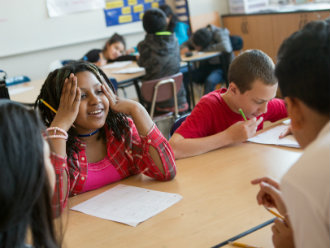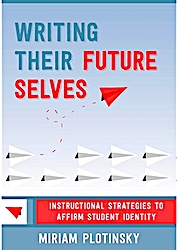Structure Feedback to Affirm Student Identity
By Miriam Plotinsky

He walks around the classroom, distributing papers and ignoring some of the more vocal reactions students express. When he gets to Danielle, he puts the essay on her desk. “Good job.”
Perplexed, Danielle picks up the essay. She has been dreading this moment because she didn’t feel confident about what she wrote, but now she sees a large “A” at the top of the page. She flips to the second page, scanning her work for feedback. There is none.
Danielle wants to be more excited about her grade, but she is more confused than anything else. There have been plenty of times that she thought she would do better on something, only to get a disappointing grade. This time, it’s the other way around. “I don’t get it,” she thinks. “I guess I’ll never know why Mr. Roberts thinks anything is good.”
Our Lack of Transparency
When students move from one class to another in middle school, they often approach each experience as a puzzle to be solved, which stems from a lack of transparency from teachers about what success looks like.
For their part, teachers do not create these opaque conditions on purpose. Instead, the misunderstandings that arise from teacher-to-student feedback are the result of flawed assumptions about how well students comprehend what is expected of them.
The result, as I point out in Writing Their Future Selves (W.W. Norton, 2023), is “a vicious cycle that perpetuates itself in classrooms as teachers wonder why students ignore feedback that could help them improve, while students do not truly understand how to interpret what teachers communicate” (p. 72).
To repair this gap in communication that I refer to as the “feedback hole,” it’s crucial to increase both the awareness and effectiveness of the systems that impart clear messages to students about their success, particularly in the middle school years when students take any perceived criticisms especially to heart.
Understand the True Meaning of Feedback
As education researcher Grant Wiggins points out in “Seven Keys to Effective Feedback,” teachers conflate feedback and grades all too frequently. For feedback to be meaningful, it has to be objective and clearly connected to criteria for success that are written in student-friendly terms.
Suppose I want a friend to pick up an apple for me from the grocery store. I probably have a list of criteria that define the apple I want, like a crispy interior and a certain ratio of sweetness to tartness. If I share these attributes with my friend (in a way that is not too annoying, let’s hope), she is more likely to buy an apple that I enjoy.
However, if I let her go to the store and bring back whatever she thinks is appropriate, it is hardly fair for me to get upset when she brings me an apple that I deem unworthy. After all, I never gave her useful information about what I wanted.

Courtesy of Allison Shelley/The Verbatim Agency for American Education: Images of Teachers and Students in Action
To extend this analogy to the classroom, teachers must share specific expectations for each assignment with students early and often. If not, we are asking them to hit invisible targets, which is unfair.
When teachers make a habit of providing criteria for success with each assignment and responding to student work by sharing how the student met the listed criteria and what they still need to do, they provide objective feedback.
If they make suggestions for where kids could improve, however, that moves away from feedback and into the realm of guidance. Any subsequent grade is evaluative and is therefore also not classified as feedback.
While guidance and evaluation have a place in student work, they lack the focused response of showing students the “why” behind their success (or lack thereof). Therefore, when teachers talk to students about giving them “feedback,” they should only be referring to student performance in relation to a specific set of criteria for success.
If teachers use that same term to include guidance and evaluation, students will value the feedback process less because it will seem subjective and perhaps tinged with bias.
Keep Success Transparent
Last week I attended a tap dance class. The teacher was performing any number of complicated steps, and I struggled to keep up. As I tried to listen to the sound my shoes were making in the cacophony of the class, I couldn’t help but wonder whether I was meeting an appropriate standard for the dance routine. Unfortunately, the instructor kept dancing throughout the hour and provided no feedback, and I went home feeling uncertain.
When teachers spend so much time working on the finer points of instruction with kids, they may assume that students know more about what is expected of them on any given assignment than is really the case. While verbally communicating expectations more than one time is helpful, students also need a clearly presented list of what the teacher considers a successful product.
Ideally, any assignment that has a significant connection to prioritized learning outcomes should include a list of expectations. To ensure that the criteria are student friendly, kids themselves should be the audience of any checklist that accompanies a task, as exemplified here:
• Your project includes two separate incidents from your assigned time period.
• You have created a clear connection between the two incidents by comparing their similarities.
• The assignment includes at least two quoted examples from the provided primary documents.
• You have gotten your project peer-reviewed using the provided handout (please attach it to your assignment as well).
When students have a criteria-for-success checklist to work from that is easy to understand, they can use it to ensure that their work meets the expected standard before turning it in. Then, when it’s time for teachers to provide feedback, the process can be streamlined by circling any listed criteria that have not been met, and using those circled items to objectively indicate what the student needs to accomplish to improve their work.
Stay Out of the Feedback Hole
When feedback exists in a vacuum, it creates a gap in communication between teachers and students – the condition I refer to as the “feedback hole.” Essentially, this issue occurs when the feedback process only goes one way (teacher-to-student, with no follow-up) and when students therefore do not understand how to improve. In this less than ideal state, kids are far more likely to disengage rather than take steps toward academic growth.
To ensure that the feedback hole doesn’t become a reality, teachers can implement a process known as “feedback on feedback” that creates a dialogue about instructional goals.
To get this practice rolling, the first thing teachers do is ask students to share some voice data at the close of a longer-term assignment or unit of study by posing open-ended questions, such as:
1. What went well for you with this assignment?
2. What is one thing that was difficult or confusing?
3. How can this process be better for you moving forward?
Once the answers to questions like these are gathered, that is step one. To follow through on what students share, going through each piece of voice data and determining how to respond is key.
Depending on what students say, it might not be possible to make the changes they suggest. However, communicating what is not possible is just as important as sharing what will be different in the future, with a clear rationale firmly attached to both.
For example, let’s suppose that a sixth-grade world studies teacher is gathering feedback about a project the class just completed in which students had to pretend to conduct a podcast interview with an historical figure. While going over the data, the teacher learns that many kids were confused about exactly what information the mock podcast should include.
It was his goal to leave a lot open to student choice, but it seems that students wanted more specific guidance. In class the next day, the teacher resolves to explain why he wasn’t as particular on this project as he is with other assignments, and he also makes a note for next time to be a lot more detailed about the criteria for success.
Teachers can communicate their “feedback on feedback” with slides, with a handout, or with any other method that prioritizes clarity. However, one thing to be wary of is only addressing student voice data through a quick verbal review. There is no guarantee when we talk that students are fully understanding or attending at any given moment, so putting our response to feedback in writing as well as going over any subsequent follow-up actions are both important.
No Secrets Teaching
When teachers correctly implement feedback to make success visible to students, the result is not just an increase in achievement. The benefits of “no secrets” teaching extend to the classroom community to build stronger relationships, empower students in safer spaces, and decrease levels of implicit bias.
The feedback hole is real, but it can easily be filled with consistent practices that keep follow-through on student voice at the forefront of our attention.

Miriam is also a National Board Certified Teacher and certified administrator and lives in Silver Spring, Maryland. Her articles have appeared at Edutopia, ASCD Express, Education Week, EdSurge and other outlets. Visit her website and follow her on X/Twitter @MirPloMCPS.




































Thank you! The “feedback on feedback” concept is helpful. Looking forward to sharing with teachers.